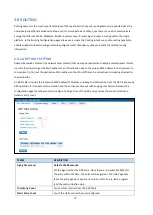
69
3.6 QUALITY of SERVICE (QoS)
Quality of Service (QoS) is the ability to provide different priority to different applications, users or data flows, or to
guarantee a certain level of performance to a data flow. QoS guarantees are important if the network capacity is
insufficient, especially for real-time streaming multimedia applications. QoS can also help to reduce traffic problems
and ensure high-priority traffic is delivered first. This section allows User to configure Traffic Prioritization settings for
each port with regard to setting priorities.
3.6.1 QoS SETTING
The figure below shows QoS Setting.
QoS Trust Mode
802.1P Priority Tag
: If 802.1P is selected the switch relies on a packet's CoS information to determine priority. This is
related to the settings in the CoS-Queue Mapping page
DSCP/TOS Code Point
: If DSCP/TOS is selected the switch relies on a packets differentiated services code point
information to determine the priority. This is related to the settings in the DSCP-Priority Mapping page.
Queue Scheduling
Select the Queue Scheduling rule:
-
Use Round Robin Scheme:
The Round Robin scheme means all the priority has the same privilege, the traffic
is forward cyclic from highest to lowest.
-
Use strict priority scheme:
The priority here always the higher queue will be processed first, except the higher
queue is empty.
-
Use Weighted Round Robin scheme.
This scheme allows users to assign new weight ratio for each class. The
10 is the highest ratio. The ratio of each class is as below:
Wx
/ W0 + W1 + W2 + W3 + W4 + W5 + W6 + W7 (Total volume of Queue 0-7)
















































